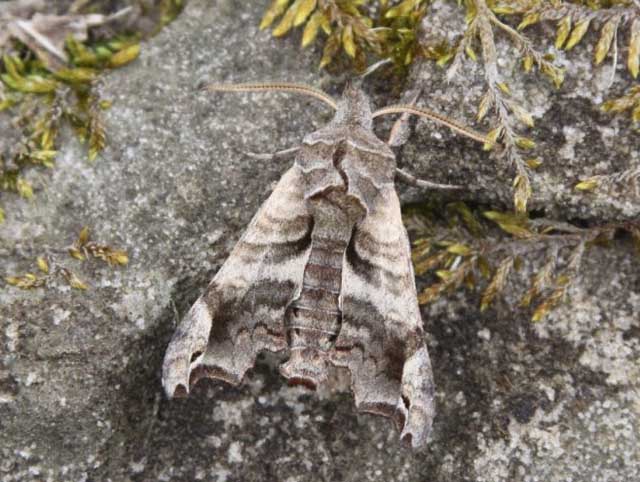Sphinginae subfamily
Sphingini tribe:
 |
Ceratomia amyntor
WO,
the Elm Sphinx or Four-horned Sphinx
The upperside of the forewing is brown with dark brown and white
markings including a white costal area near the wing base, dark
streaks along the veins, and a white spot in the cell.
Larvae feed on Elm (Ulmus), birch (Betula), basswood (Tilia), and
cherry (Prunus).
|

|
The upperside of the forewing is yellowish brown with no white markings, but there are indistinct black lines and dashes.
The cell spot is gray with a black outline. The larvae feed in large groups and are much more
spectacular than the moths.
Catalpa is the larval host. slight possibility, confirmed by Dan Jackson
|
Ceratomia catalpae larva, October 2, 2011, Chaseburg, Dan Jackson
 |
The upperside of the forewing is pale brownish gray with wavy black
and white lines and a black-outlined white cell spot.
|
Ceratomia undulosa, Chaseburg, August 9, 2010, Dan Jackson
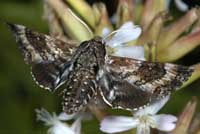 |
Dolba hyloeus
WO, the Pawpaw Sphinx
The upperside of the forewing is dark brown with a dusting of
white scales. Some moths have patches of reddish or yellowish
brown on the wings.
Larve are not limited to pawpaw.
|
 |
This species is not officially reported from La Crosse.
If you have pines, you
probably have this species. It also flies on P.E.I.
|
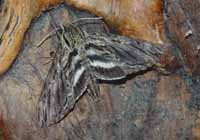 |
Lintneria eremitus
WO, the
Hermit Sphinx
The upperside of the forewing is gray-brown with wavy lines, black
dashes, and one or two small white spots near the center of the
costa. The upperside of the hindwing is black with two white bands
and a triangular black patch at the base. Note the golden hair on the
thorax.
|
 |
This large bodied moth flies in tobacco fields and vegetable gardens
(potatoes, tomatoes) and wherever host plants are found.
|

|
Sphinx canadensis
WO,
Sphinx canadensis, the Canadian Sphinx, is not common, and is not
often reported anywhere,
but it might be present in Trempealeau County.
Larval hosts are white ash (Fraxinus americana) and blueberry
(Vaccinium).
|
 |
Sphinx chersis
WO, the Northern Ash Sphinx or Great Ash Sphinx
The upperside of the forewing is soft dark gray to blue-gray
with a series of black dashes, one of which reaches the wing tip.
|
 |
We have them
on P.E.I., but I do not see them nearly as frequently
as I see the other Sphingidae.
|
 |
Note the pm line, absent in Sphinx poecila which flies
more to the north.
|
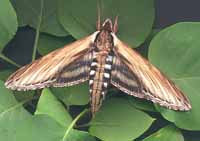 |
The lower forewings are predominantly brownish-yellow with a fairly
wide dark bar along the inner margin. At rest the wings hug the body,
giving the moth a long slender look.
|
 |
Sphinx luscitiosa
WO,
the Canadian Sphinx or
Clemen's Sphinx:
The upperside of the forewing is yellowish gray in males and pale
gray with a faint yellow tint in females. In both sexes, the dark
border on the outer margin widens as it approaches the inner margin.
|
 |
If you have blueberries in the woods, then you probably have the
Poecila Sphinx. They are probably widespread throughout Wisconsin,
but are very much under reported.
|
 |
The upperside of the forewing has a narrow black subterminal line
bordered by a white inverted V-shaped line on the outside, and a
black line running inwards from the apex of the wing.
It is most often found in montane woodlands and along streamcourses.
|
Smerinthini Tribe:
 |
The adults are also highly variable; sometimes wings of an individual
may be all one color or may have several colors, ranging from pale to
dark brown, and may have a white or pink tinge.
See the file for the female; she is different.
|
Amorpha juglandis, Chaseburg, June 1, 2011, May 11, 2012, Dan Jackson
 |
Pachysphinx modesta
DJ,
the Modest Sphinx or Poplar Sphinx,
This large poplar/willow feeder is not reported in Trempealeau
County, but it is probably present.
They are a heavy bodied species.
|
Pachysphinx modesta, Chaseburg, July 15, 2007, May 30, 2010, Dan Jackson
 |
The outer margin of the forewing is quite wavy. There is a dark cell
spot and a dark oblique line mid wing from the costa almost to the
inner margin. Basic ground colour is pinkish brown. Flight would
be June-July.
|
Paonias excaecata, Chaseburg, July 1, 2009, Dan Jackson
 |
Paonias myops
WO/DJ,
the Small-eyed Sphinx
This small species is confirmed in Trempealeau County by Ian Miller.
This species ranges across North America.
The hindwings have a small blue eyespot ringed with black on a yellow
background.
|
Paonias myops, Chaseburg, June 1, 2011, May 3, 2012, Dan Jackson
 |
Smerinthus cerisyi
DJ, the Cerisyi's
Sphinx or One-eyed Sphinx, Larvae feed on poplars and willows.
Flight would be from late May-July as a single brood.
|
Smerinthus cerisyi, Chaseburg, June 1, 2008, Dan Jackson
 |
Smerinthus jamaicensis closely resembles Smerinthus cerisyi, but
jamaicensis is much smaller with larger blue patches on more vibrant
and deeper purple in the lower wings.
|
Smerinthus jamaicensis, Chaseburg, May 3, 2012, Dan Jackson
Macroglossinae subfamily
Dilophonotini Tribe:
See Hemaris comparison to help distinguish
the next three species.
 |
Hemaris diffinis
DJ, the Snowberry Clearwing or Bumblebee Moth,
The moth flies along forest edges and in meadows, gardens and
brushy fields. Day-flying adults nectar at lantana, dwarf bush honeysuckle,
snowberry, orange hawkweed, thistles, lilac, Canada violet, etc.
|
Hemaris diffinis, Stoddard, July 15, 2009, Dan Jackson
 |
Hemaris thysbe
DJ, the Hummingbird Clearwing
It is not difficult to see why many gardeners would mistake an
Hemaris thysbe moth for a small hummingbird as it hovers, sipping
nectar from flowers through a long feeding tube.
|
Philampelini Tribe:
 |
This moth is not reported for Trempealeau,
but it may be present.
Note the differences between this moth and the Pandorus Sphinx.
|
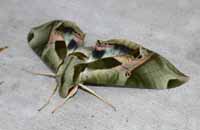 |
If you have Grape or Virginia Creeper nearby, then you might have
this species. I often get asked to identify larvae from areas where
they have not previously been reported.
|
Macroglossini Tribe:
 |
This day flier is widely distributed. If you have Virginia Creeper,
you probably have the Nessus Sphinx. Two bright, distinct, narrow
yellow bands are often visible on the abdomen.
|
 |
The lower wings of this hawkmoth are a solid brownish-orange,
matching the body colour.
You will often see this species listed as Darapsa pholus,
especially in older literature.
|
 |
Darapsa myron
DJ, the Virginia Creeper Sphinx or the
Grapevine Sphinx
The forewing upperside is dark brown to pale yellowish gray, with an
olive tint.
On the costal margin there is a dark rectangular patch, although
this may be reduced or absent. The upperside of the hindwing is pale
orange.
|
Darapsa myron, Chaseburg, June 3, 2008, Dan Jackson
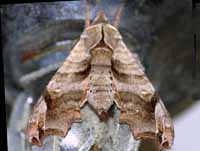 |
The moth's outer margin of the forewing is deeply scalloped.
The upperside is light brown with dark brown markings.
There is a small black and white spot near the tip.
The upperside of the hindwing is orange-brown with a dark brown
outer margin and median line.
|
Deidamia inscriptum adult moth, Chaseburg, May 7, 2011, courtesy of Dan Jackson
 |
Hyles gallii
WO, the Bedstraw Hawk Moth
or Gallium Sphinx
This species is not reported in La Crosse, but it has been recorded in
eastern Wisconsin counties. I suspect it is present.
Some years I see them on P.E.I., some years, I do not.
|
 |
Hyles lineata
DJ, the White-lined Sphinx
Adults usually fly at dusk, during the night, and at dawn, but they
also fly during the day over a wide variety of open habitats
including deserts, suburbs, and gardens.
|
Hyles lineata, Chaseburg, August 16, 2010; May 11, 2012, Dan Jackson
 |
This moth is very much under reported on USGS. It is a
rapid day flier so is probably not in too many collections.
Grape is a popular larval host.
|
|
|
